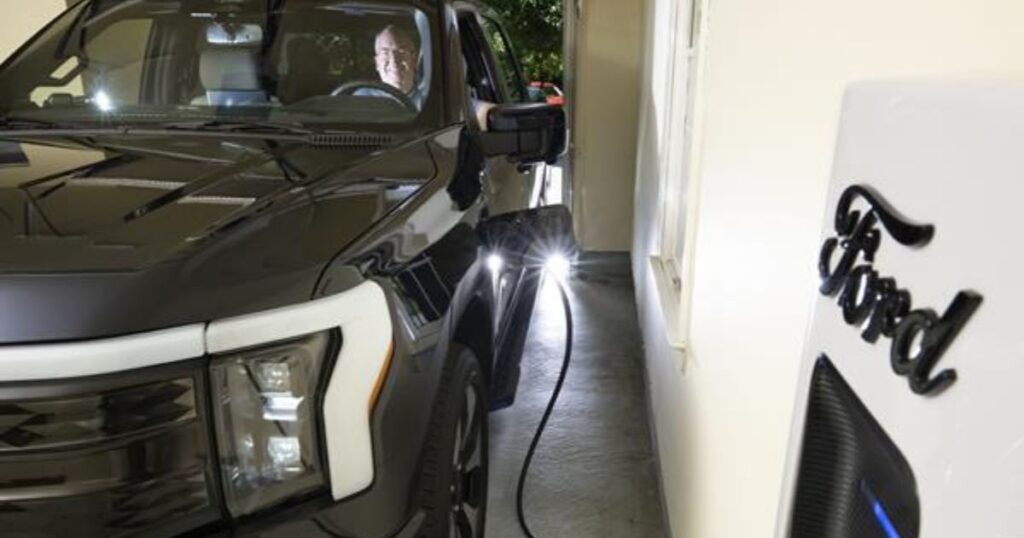Sunrun Inc., the nation’s leading provider of clean energy as a subscription service, has launched the first operational vehicle-to-home (V2H) power plant in the United States. This initiative utilizes a small group of customer-owned bidirectional electric vehicles to support Maryland’s power grid during peak demand times. Partnering with Baltimore Gas and Electric Company (BGE), a subsidiary of Exelon Corporation, the project aims to enhance grid resiliency and stabilize utility prices.
Understanding Vehicle-to-Home (V2H)
V2H technology transforms EVs into energy storage units for residential homes. This approach allows energy stored in an EV’s battery to be discharged back into the home’s electrical system during peak demand periods or power outages.
V2H systems use a bidirectional charging setup connecting the EV to the home’s electrical infrastructure. This setup enables the EV to draw power from the grid and supply power back to the house. During the day, the EV can power a home, helping to avoid high energy prices during peak periods. At night, when electricity prices are lower, the EV can be charged, taking advantage of off-peak rates. In a power outage, the EV can provide backup power to keep essential appliances and devices running.
Homeowners can reduce their electricity bills by using stored energy from the EV during peak hours and charging during off-peak hours. V2H enhances energy independence by reducing reliance on the grid, particularly during outages, providing a reliable energy source. Utilizing V2H technology optimizes renewable energy sources, contributing to a more sustainable energy system and reducing the overall carbon footprint.
Ford F-150 Lightning Trucks Powering Homes
The program involves three Sunrun customers within BGE’s service territory who own all-electric Ford F-150 Lightning trucks equipped with the Ford Charge Station Pro and Home Integration System, exclusively sold through Sunrun. By discharging the F-150 Lightnings’ onboard batteries directly to participants’ homes, the initiative showcases how electric vehicles can function as stationary batteries, reducing grid demand and increasing energy system reliability.
From June 1 to September 30, 2024, Sunrun will network and monitor the enrolled trucks as they share stored energy during dispatch windows from 5 p.m. to 9 p.m. on weekdays. Participating customers will receive payments estimated at $800 over the four months based on the energy shared.
Strategic Collaboration and Future Expansion
“This program is a significant proof of concept—no other market player has done this,” said Mary Powell, CEO of Sunrun. “This exciting partnership lays the foundation for the power grid of the future where electric vehicle owners can contribute to grid resiliency and utility price stability for everyone.”
BGE was awarded grant funding from the Department of Energy to create an electric vehicle virtual power plant. Partnering with Sunrun to develop and administer the program, BGE aims to assist its system during peak energy consumption times. “We know that the power stored in electric vehicles will be essential in our state’s effort to achieve its bold net-zero emissions goals,” stated Mark Case, Vice President of Regulatory Policy and Strategy at BGE.
Ford’s Role and Legislative Support
Sunrun has an existing partnership with Ford Motor Company to serve as the preferred installer for Ford Intelligent Backup Power. This includes the Ford Charge Station Pro and the co-developed Home Integration System—the first commercially available bidirectional system in the U.S. The Intelligent Backup Power allows customers to use bidirectional technology from their all-electric truck to power their homes for up to 10 days during an outage, depending on energy usage.
State Delegate David Fraser-Hidalgo praised the collaboration: “The ability of Ford’s F-150 Lightning to support the electric grid and generate revenue for the owner while parked at home is a game-changing moment for electric vehicles in Maryland and nationwide. Maryland has established itself as first in the nation on vehicle-to-home innovation.”
Behavior Insights and Future Programs
In addition to demonstrating vehicle-to-home capabilities, the program aims to understand the behaviors and preferences of EV owners. Insights gained will help Sunrun and BGE explore expanding the program, offering incentives for existing F-150 Lightning owners to adopt bidirectional charging, and developing vehicle-to-grid capabilities for community-wide energy sharing.
Chris Rauscher, Sunrun’s Head of Grid Services, emphasized the collaborative effort: “Virtual power plants with bidirectional electric vehicles will play a key role in the clean energy transition. We look forward to scaling these innovative programs with BGE and other utilities around the country.”
Future of V2H
Currently, only a few EV models support V2H technology. Notable examples include the Nissan Leaf and Mitsubishi Outlander PHEV. However, more manufacturers, including General Motors and Tesla, are expected to introduce V2H-compatible models soon.
The integration of V2H technology is expected to grow alongside the increasing adoption of EVs globally. This technology holds significant promise for optimizing energy usage and promoting sustainability at the residential level, making it a key component in the future of energy management.
Original Story at www.environmentenergyleader.com
